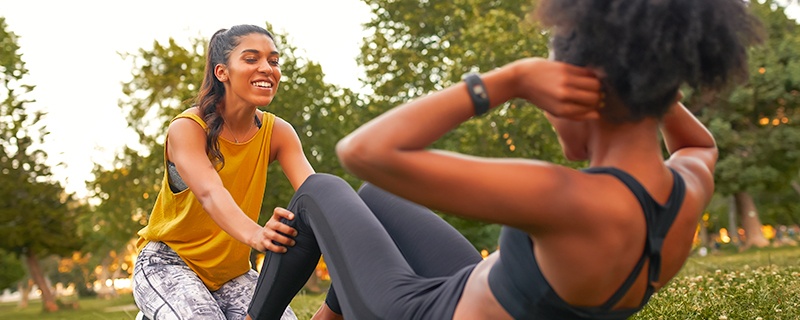Summer is here! The days are long, kids are home from school, and there are seemingly endless amounts of activities and sunshine. Here are our top summer health tips to learn for a safe and healthy season.
How much time in the sun is safe?
A safe level of sun exposure largely depends on the level of UV radiation. Higher levels of UV radiation mean your skin is more likely to sunburn, and you’ll need more protection. In Texas summers, it’s not uncommon for the UV index to reach the highest intensity levels. You can check the hourly UV index here.
UV Index

The amount of time you can safely spend in the sun also depends on your skin type. People with the lightest skin — often with freckles — can get sunburned from UV radiation after only 10 minutes. People with the darkest skin can typically spend more than 60 minutes in the sun before they burn. You’re most likely to burn if you’re in the sun between 10 a.m. and 4 p.m.
Sun safety tips
With temperatures and UV levels like these, protection from the sun is a top priority. However, this doesn’t mean you have to stay inside and avoid the sun at all costs. You can still enjoy it safely and soak up vitamin D. Here are some ways to stay safe in the sun:
- Limit your sun exposure during the times of day when UV levels are strongest.
- Wear protective clothing, like lightweight cotton or linen sleeves and pants, hats, and sunglasses.
- Use sunscreen that’s at least 30 SPF. Put it on 15 minutes before you head outdoors, and reapply every two hours or after swimming or sweating.
Read our blog on sun safety for more information.

Healthy summer eating
Part of looking and feeling your best this summer is maintaining a good diet. For starters, be sure to manage your portion sizes and eat in moderation. Your plate should be balanced, as well, containing half fruits and vegetables, and grains, protein, and dairy in the other half.
Enjoy summer produce
Healthy summer eating can be easy because so many wonderful types of produce are in season at this time of the year. Some of the great seasonal produce you can enjoy in the summertime is:
- Tomatoes
- Avocados
- Bananas
- Bell pepper
- Blueberries and blackberries
- Watermelon
- Corn
- Cucumbers
- Green beans
- Eggplant
- And so much more! Check out the U.S. Department of Agriculture’s guide to seasonal produce for inspiration.
Summer also means grilling season, and many of these vegetables are made even more delicious when cooked on the grill!
Eat healthy while dining out
It’s not uncommon for people to eat out in restaurants more frequently in the summer. Staying healthy at restaurants is trickier than when cooking and dining at home, but it is doable. Here are some ways you can eat healthy at restaurants:
- Restaurant portions are typically oversized. Before you dine out, know what a proper portion size looks like, and eat that amount of your meal. Pack the rest in a to-go box and enjoy it later.
- Look up the restaurant’s menu before you go out so you can pre-plan your healthy order.
- Order a salad as your first course. This will help you eat more vegetables while filling you before your entree.
- Opt for dishes that are grilled, baked, or steamed rather than breaded, smothered, or buttery.
- Ask for dressing and sauces on the side so you can control the amount you use.
- For alcoholic beverages, choose a lower calorie option like red wine or vodka soda.
Both in terms of healthy summer eating and sun/heat safety — be sure to stay hydrated every step of the way! Water is the best choice because it’s calorie-, sugar-, and sodium-free!

What you need to know about exercising in the heat
Keeping your body moving is an important part of staying healthy in the summertime. But what about when it’s this hot outside? Are there ways to safely exercise in the summer heat?
Before we get into how you can exercise in the summer, it’s important to understand the relationship between temperature and physical exertion. Your core body temperature rises from both exercise and outdoor heat and humidity. The way the body cools itself down is through sweating and increasing your blood circulation. This causes your heart rate to rise. Additionally, high humidity can prevent the sweat from evaporating, which makes your body temperature go up even more. If your body isn’t able to successfully cool itself down, you may experience a heat-related illness, like heat cramps, heat exhaustion, or heatstroke.
Signs of heat-related illnesses to be aware of are:
- Weakness
- Fatigue
- Dizziness
- Muscle cramps
- Fainting
- Headache
- Nausea or vomiting
If you plan to exercise in the summer heat, this is what you can do to stay safe:
- Wear light-colored, lightweight, loose-fitting clothing.
- Avoid exercising during the hottest hours — 10 a.m. – 4 p.m.
- Drink plenty of fluids — even if you don’t feel thirsty. Sports drinks with electrolytes can help.
- Wear sunscreen.
- Incorporate water into your summer workout if possible, like swimming laps or jogging on a rainy day.
- Understand that you may need to scale back your workout in hot weather. A routine you can do easily on a mild day will feel much more intense on a hot day.
- Consider breaking up your workout into smaller workouts throughout the day.
- Move your workout indoors on days with heat advisories.
Stay safe this summer
We hope these summer health and safety tips help you stay safe and cool! If you ever need emergency medical attention for heat stroke, dehydration, accidents, or falls, we’re here for you and your family 24/7/365 — even on holidays. We treat all adult and pediatric emergencies. Click here to find your nearest Neighbors Emergency Center.

